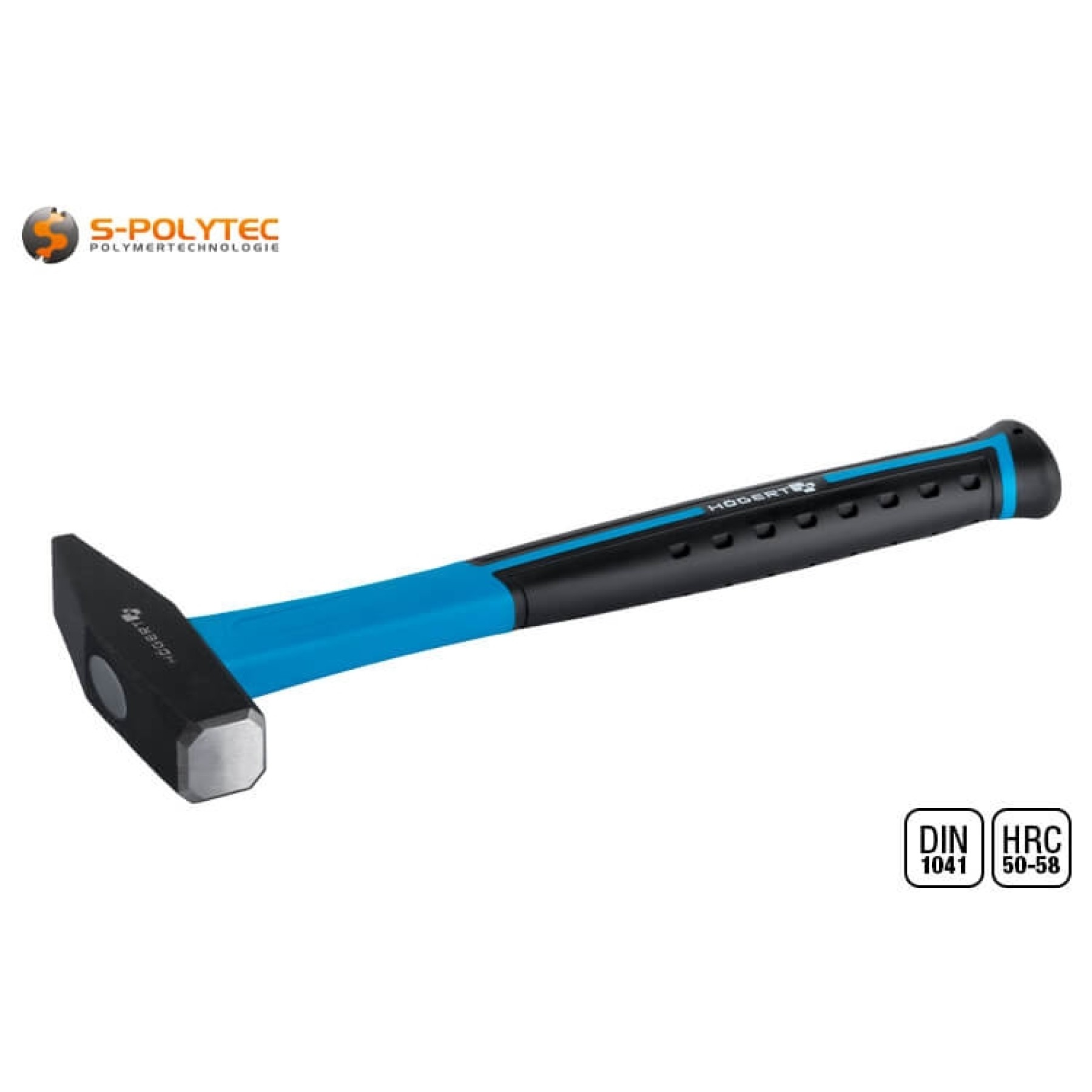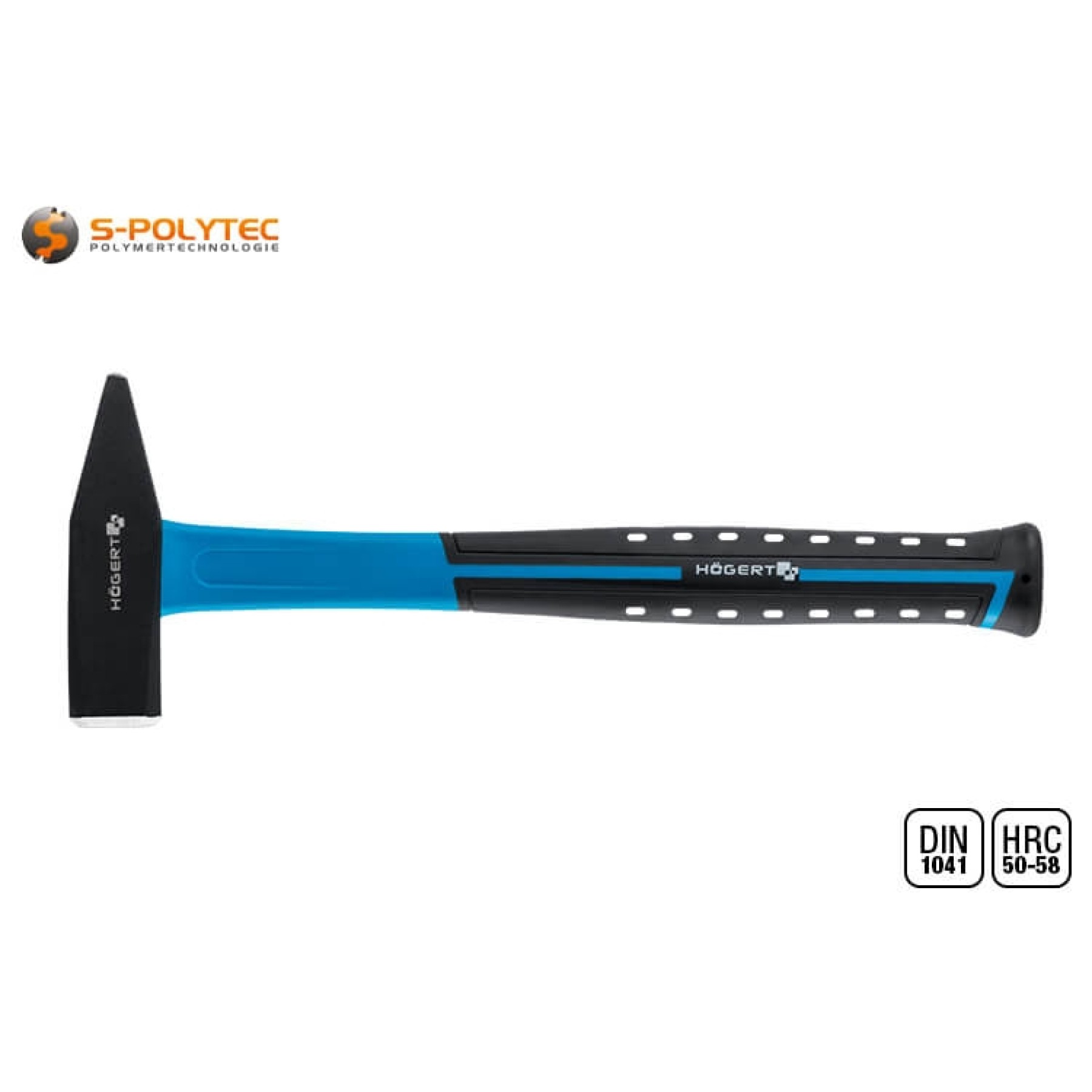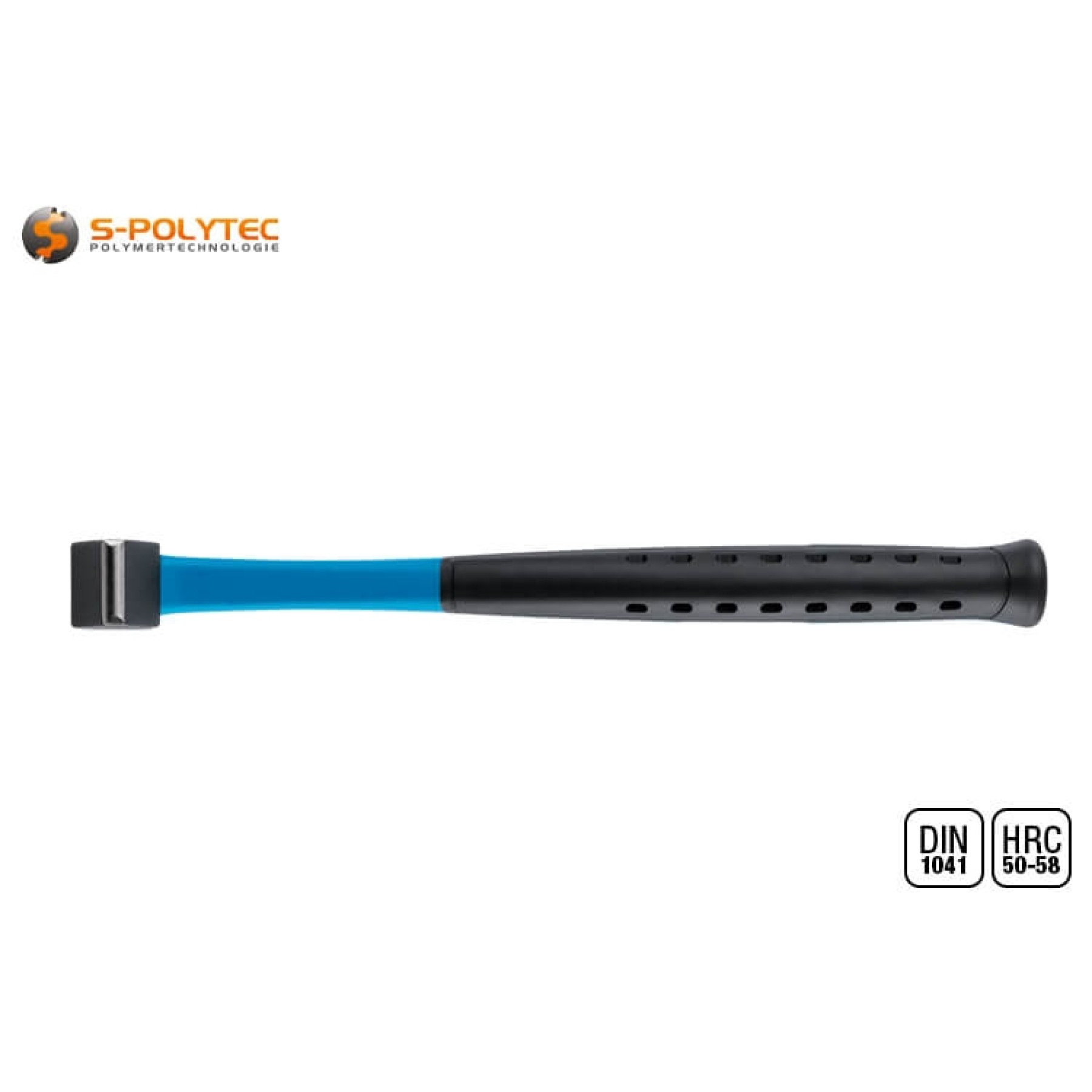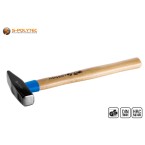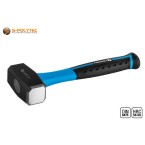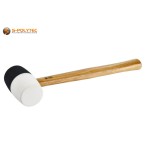
Locksmith's hammer with fibreglass handle (various sizes)
The Högert locksmith's hammer with vibration-damping fibreglass handle is forged from high-quality C45 carbon steel in accordance with DIN 1041 with web and fin and has a non-slip, rubberised grip surface.
✓ C45 carbon steel head
✓ Robust fibreglass handle
✓ Hardened fin and track
✓ Head shape according to DIN 1041
✓ Vibration-damping
The locksmith's hammers with fibreglass handles are available from us in various sizes with 300g, 500g or 800g head weights.
The item is in stock
Dispatch within 2 - 3 working days
- calculate the price
0,00 € / pc.
0,0000 kg / pc.
All prices include 19% VAT.
- Description
Locksmith's hammer with vibration-damping fibreglass handle
Rubberised 2-component handle ✓ Various sizes ✓ According to DIN 1041 ✓
The Högert locksmith's hammer with fibreglass handle is the high-quality version of the classic hammer with wooden handle and is characterised by its very high quality and durability. A locksmith's hammer is the most common type of hammer and can be found in almost every workshop, every toolbox and every household. The typical head shape, which is manufactured in accordance with DIN 1041, is reminiscent of a house when viewed from the side and has a square striking surface, known as the web, and a rounded, narrow surface on the opposite side, known as the fin. The head is forged from a high-quality CS45 carbon steel, the web and fin of which are also specially hardened to achieve high wear resistance of the striking surfaces. The degree of hardness is 50-58 HRC. As a professional tool, the locksmith's hammer with fibreglass handle impresses with its excellent workmanship and meets even the highest demands of the trade in countless areas.
The multi-component fibreglass construction of the handle ensures an optimum balance between comfort, weight and durability. The fibreglass core effectively absorbs shocks and vibrations and is coated with a robust plastic that is resistant to moisture and UV radiation. The ergonomic shape of the handle, combined with the rubberised grip surface, guarantees a firm, secure grip and minimises fatigue during prolonged use.
Features of the locksmith's hammer with fibreglass handle from Högert
With the locksmith's hammer from Högert with shock- and vibration-absorbing fibreglass handle, we offer a professional hammer in craftsman quality at affordable prices. The hammer head is forged from high-quality C45 carbon steel with a hardened face consisting of web and fin. The ergonomic handle has a fibreglass core, which is coated with a robust and hard-wearing plastic. The grip surface has a non-slip rubber coating. The length and diameter of the fibreglass handle are perfectly matched to the weight of the hammer head. We stock locksmith's hammers in various sizes with a head weight of 300 grams, 500 grams or even 800 grams, so that the right hammer can be ordered depending on personal preferences and tailored to the predominant activities and areas of application.
The main component of a locksmith's hammer is the hammer head, the shape of which is defined by DIN 1041. This consists of forged carbon steel, which is hardened in a separate work step in the area of the striking surfaces in order to achieve a high material hardness of 50-58HRC (Rockwell hardness). This makes the hammer virtually indestructible and can easily withstand even powerful blows on iron, steel or concrete without affecting the striking surfaces or the durability of the hammer. The main features of a locksmith's hammer, the head of which is called a house in reference to the side view, are the web and the fin. The web is the large square striking surface, which is suitable for hammering nails or driving chisels and wood chisels. It is slightly chamfered on the outer edges to reduce the sharp edges and thus minimise excessive indentations caused by angled impact of the sheet. The fin is located on the opposite side. On this side, the hammer head tapers evenly on both the upper and lower sides in order to achieve a narrower striking surface for picking, wedging or spreading. The fin is also rounded rather than sharp-edged. The small surface is particularly helpful for delicate work, such as fixing nails before they are hammered in with the web. In addition, the impact force when hitting the surface is reduced to a much smaller impact area, which is a great advantage, especially when chipping plaster, edging and moulding metals or breaking stones.
The high-quality handle consists of several components that work in unison to significantly reduce shocks and vibrations caused by the impact force of the hammer. These include the strong fibreglass core, which contributes to the very high stability and impact resistance of the handle. This is coated with a hard-wearing plastic in a blue colour typical of the Högert brand. The sheathing protects the fibreglass core and also increases the handle diameter in order to achieve a good grip. The ergonomic grip surface itself is generously dimensioned and has a pleasantly soft rubber coating to ensure that the hammer always sits comfortably in the hand and does not slip out of it. The grip surface has many small holes on both sides that run right through the rubber. These serve to cushion the impact and help to protect the wrist and prevent aching joints even during prolonged work.
Advantages of the Högert locksmith's hammer with fibreglass handle
- The locksmith's hammer is manufactured in accordance with DIN 1041
- The fin and track of the house-shaped hammer head made of C45 steel are specially hardened
- The robust handle with plastic-coated fibreglass core reduces vibrations and shocks
- The non-slip, rubberised grip surface ensures a firm, non-slip grip
- A solid metal wedge permanently joins the fibreglass handle to the head
- The perfect balance of the central handle position guarantees optimum handling
- The impact path is chamfered to minimise impact damage and injuries
- In contrast to wood, fibreglass is extremely resistant and rot-proof
- The handle length with rubberised grip area is optimally matched to the head size
The size and weight of the fitter's hammer vary depending on the model and intended use. The heavier models with 500g or 800g are well suited for robust construction work due to their higher weight and larger impact path, while the lighter hammer with 300g head weight can be used for more precise tasks. The handle, whose length is optimally matched to the head size, has a shock-resistant plastic coating on the fibreglass core and combines low weight with effective protection of the core.
Specific data of the locksmith's hammer with fibreglass handle
- Locksmith's hammer 300g:Head weight: 300mm, track: approx. 23.1mm x 23.1mm, fin: approx. 22.0mm x 5.5mm, house: approx. 105mm
- Locksmith's hammer 500g:Head weight: 500mm, track: approx. 27.8mm x 27.8mm, fin: approx. 27.0mm x 7.5mm, house: approx. 120mm
- Locksmith's hammer 800g:Head weight: 800mm, track: approx. 33.4mm x 33.4mm, fin: approx. 32.5mm x 7.5mm, house: approx. 130mm
Use and handling of a locksmith's hammer
When people talk about a hammer in everyday language, they usually mean a locksmith's hammer, as this is the most common and is included in almost every toolbox. Everyone knows this type of hammer. Originally used as a tool for working metal in locksmiths' shops, the locksmith's hammer is used by almost every tradesman for a wide range of different jobs. This is thanks to the well-balanced design of the head with a square face and a narrow fin. Probably the most common use of this type of hammer is for hammering in nails, for example to hang a picture on the wall or to nail boards, battens and beams. The large, smooth face on one side offers a high level of accuracy and, depending on the hammer size, is matched to the weight of the head to achieve the greatest possible impact force. The length of the hammer handle plays a decisive role here. If it is too long, hammering precision is made more difficult. If the handle is too short, precision is increased but at the expense of impact force. The optimum grip position at the end of the handle achieves a good balance between power and accuracy.
The fin is located opposite the large, angular striking path, which is more suitable for more delicate work, such as fixing small nails and pins, due to its significantly narrower, rounded surface. The tapered fin is also very suitable for knocking loose plaster off the wall or hammering notches into the surface. The fin can also be very useful as a wedge, for example to raise a gap in wood or between two cabinets, by inserting this side of the hammer head into the gap and using the handle as a lever. The fin can also be used in the same way to spread nailed boards, battens and beams. On delicate or painted surfaces, a cloth can protect against scratches caused by contact with the carbon steel head.
With our various locksmith hammers, we offer the option of selecting the right size with the right head weight for the task at hand and personal preference. While a small hammer with a 300g head weight is most likely to be sufficient for domestic use, a heavier hammer is usually preferred in the construction sector, although the weight also varies from trade to trade. Especially if the hammer is used frequently, choosing the right hammer size can lead to more efficient and precise work. A hammer that is too heavy can cause premature fatigue, while a hammer that is too light may not provide enough force for certain tasks. Hammering nails into wooden materials can still be achieved with all of the sizes. On the other hand, a solid impact anchor for fastening a heavy-duty shelf can hardly be driven into concrete with a small hammer. For such tasks, as well as for chiselling, demolition or masonry work, more impact force is required, so 500g head weight or more is the better choice.
TIP: A locksmith's hammer, and this also applies to any other hammer, is used for striking and this always means that splintering of the material being struck cannot be ruled out, so safety goggles and work gloves are recommended as personal protective equipment.
Technical data of the fibreglass hammer
- Product type: Hammer
- Material (Head): hardened C45 Steel
- Material (Handle): 2k-fibreglass (rubberised)
- Head shape: Locksmith's hammer
- DIN Norm: DIN 1041
- Weight (Head): 300g, 500g resp. 800g
- Shape fin: Narrow
- Shape track: Square
- Length (Handle): approx. 27.5cm, 28.5cm resp. 32.5cm
- Weight (Handle: approx. 185g, 255g resp. 305g
- Length (Total): approx. 30cm, 31.5cm resp. 35.5cm
- Weight (Total): approx. 485g, 755g resp. 1105g
- Commercial Use: Permissible
Storage and care of the locksmith's hammer with fibreglass handle
The advantage of a fibreglass hammer is that it does not require any special care or storage. In order to maintain the visual integrity of the hammer, coarse dirt on the striking surfaces, such as plaster residue, should always be wiped off with a cloth after use. The handle, especially the holes in the handle, should also be cleaned occasionally, as these could become clogged with dust, sand or other dirt over time and this affects the vibration-damping properties of the handle surface.
WARNING: Although the locksmith's hammer has a hardened face and fin, these striking surfaces should never be struck with a second hammer, as this can damage the hammer head or impair the firm connection of the hammer handle.
- Additional Information
Additional Information
Product-ID SHMR000 Delivery Time Dispatch within 2 - 3 working days Property Head weight varies Material Hardened C45 steel Color No - Reviews
